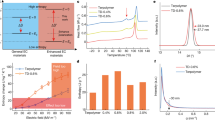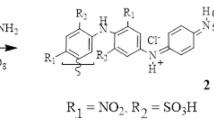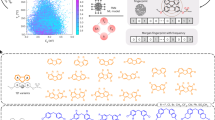Abstract
A new class of aryl trifluorovinyl ether monomers were designed and synthesized, and novel fluorinated polymers containing perfluorocyclobutane and 1H-1,2,3-triazole units were prepared from these monomers. These polymers were characterized by nuclear magnetic resonance spectroscopy, thermo-gravimetric analysis and differential scanning calorimetry. The temperatures of 5% weight loss of the polymers under nitrogen were up to ∼290 °C, and the glass transition temperatures of the polymers were in the range of 79–110 °C. These new polymers showed good solubility in common organic solvents such as dimethyl sulfoxide and N,N-dimethylacetamide. In addition, the proton conductivity of the polymers was measured under anhydrous conditions using impedance spectroscopy, and a maximum conductivity of 2.85 μS cm−1 was obtained at 200 °C.
Similar content being viewed by others
Log in or create a free account to read this content
Gain free access to this article, as well as selected content from this journal and more on nature.com
or
References
Zhang, J., Xie, Z., Zhang, J., Tang, Y., Song, C., Navessin, T., Shi, Z., Song, D., Wang, H., Wilkinson, D. P., Liu, Z.- S. & Holdcroft, S. High temperature PEM fuel cells. J. Power Sources 160, 872–891 (2006).
de Bruijn, F. A., Makkus, R. C., Mallant, R.K.A.M. & Janssen, G. J. M. Chapter five materials for state-of-the-art PEM fuel cells, and their suitability for operation above 100 °C. Adv. Fuel Cells 1, 235–336 (2007).
Mader, J., Xiao, L., Schmidt, T. J. & Benicewicz, B. C. Polybenzimidazole/acid complexes as high-temperature membranes. Adv. Polym. Sci. 216, 63–124 (2008).
Li, Q., He, R., Jensen, J. O. & Bjerrum, N. J. Approaches and recent development of polymer electrolyte membranes for fuel cells operating above 100 °C. Chem. Mater. 15, 4896–4915 (2003).
Wang, J. T., Savinell, R. F., Wainright, J., Litt, M. & Yu, H. A H2/O2 fuel cell using acid doped polybenzimidazole as polymer electrolyte. Electrochim. Acta. 41, 193–197 (1996).
Bozkurt, A., Ise, M., Kreuer, K. D., Meyer, W. H. & Wegner, G. Proton conducting polymer electrolytes based on phosphoric acid. Solid State Ionics 125, 225–233 (1999).
Miyake, N., Wainright, J. S. & Savinell, R. F. Evaluation of a sol-gel derived Nafion/silica hybrid membrane for proton electrolyte membrane fuel cell applications. J. Electrochem. Soc. 148, A898–A904 (2001).
Pu, H., Liu, Q. & Liu, G. Methanol permeation and proton conductivity of acid-doped poly(N-ethylbenzimidazole) and poly(N-methylbenzimidazole). J. Membr. Sci. 241, 169–175 (2004).
Schuster, M., Meyer, W. H., Wegner, G., Herz, H. G., Ise, M., Schuster, M., Kreuer, K. D. & Maier, J. Proton mobility in oligomer-bound proton solvents: imidazole immobilization via flexible spacers. Solid State Ionics 145, 85–92 (2001).
Persson, J. C. & Jannasch, P. Self-conducting benzimidazole oligomers for proton transport. Chem. Mater. 15, 3044–3045 (2003).
Jeske, M., Soltmann, C., Ellenberg, C., Wilhelm, M., Koch, D. & Grathwoh, G. Proton conducting membranes for the high temperature polymer electrolyte membrane fuel cell (HT-PEMFC) based on functionalized polysiloxanes. Fuel Cells 7, 40–46 (2007).
Woudenberg, R. C., Yavuzcetin, O., Tuominen, M. T. & Coughlin, E. B. Intrinsically proton conducting polymers and copolymers containing benzimidazole moieties: glass transition effects. Solid State Ionics 178, 1135–1141 (2007).
Zhou, Z., Li, S., Zhang, Y., Liu, M. & Li, W. Promotion of proton conduction in polymer electrolyte membranes by 1H-1,2,3-triazole. J. Am. Chem. Soc. 127, 10824–10825 (2005).
Subbaraman, R., Ghassemi, H. & Zawodzinski, T. A. Jr 4,5-Dicyano-1H-[1,2,3]-triazole as a proton transport facilitator for polymer electrolyte membrane fuel cells. J. Am. Chem. Soc. 129, 2238–2239 (2007).
Martwiset, S., Woudenberg, R. C., Granados-Focil, S., Yavuzcetin, O., Tuominen, M. T. & Coughlin, E. B. Intrinsically conducting polymers and copolymers containing triazole moieties. Solid State Ionics 178, 1398–1403 (2007).
Martwiset, S., Yavuzcetin, O., Thorn, M., Versek, C., Tuominen, M. & Coughlin, E. B. Proton conducting polymers containing 1H-1,2,3-triazole moieties. J. Polym. Sci. Part A Polym. Chem. 47, 188–196 (2009).
Nagamani, C., Versek, C., Thorn, M., Tuominen, M. T. & Thayumanavan, S. Proton conduction in 1H-1,2,3-triazole polymers: imidazole-like or pyrazole-like? J. Polym. Sci. Part A Polym. Chem. 48, 1851–1858 (2010).
Frutsaert, G., Delon, L., David, D., Ameduri, B., Jones, D., Glipa, X. & Roziers, J. Synthesis and properties of new fluorinated polymers bearing pendant imidazole groups for fuel cell membranes operating over a broad relative humidity range. J. Polym. Sci. Part A Polym. Chem. 48, 223–231 (2010).
Babb, D. A., Ezzell, B. R., Clement, K. S., Richey, W. F. & Kennedy, A. P. Perfluorocyclobutane aromatic ether polymers. J. Polym. Sci. Part A Polym. Chem. 31, 3465–3477 (1993).
Smith, D. W. Jr, Babb, D. A., Shah, H. V., Hoeglund, A., Traiphol, R., Perahia, D., Boone, H. W., Langhoff, C. & Radler, M. Perfluorocyclobutane (PFCB) polyaryl ethers: versatile coatings materials. J. Fluorine Chem. 104, 109–117 (2000).
Zhu, Y., Huang, Y., Meng, W.- D., Li, H. & Qing, F.- L. Novel perfluorocyclobutyl (PFCB)-containing polymers formed by click chemistry. Polymer 47, 6272–6279 (2006).
Ford, L. A., DesMarteau, D. D. & Smith, D. W. Jr Perfluorocyclobutyl (PFCB) aromatic polyethers: synthesis and characterization of new sulfonimide containing monomers and fluoropolymers. J. Fluorine Chem. 126, 651–658 (2005).
Kim, D.- J., Chang, B.- J., Kim, J.- H., Lee, S.- B. & Joo, H.- J. Sulfonated poly(fluorenyl ether) membranes containing perfluorocyclobutane groups for fuel cell applications. J. Membrane Sci. 325, 217–222 (2008).
Lu, G., Lam, S. & Burgess, K. An iterative route to ‘decorated’ ethylene glycol-based linkers. Chem. Commun. 2006, 1652–1654 (2006).
Loren, J. C., Krasinski, A., Fokin, V. V. & Sharpless, K. B. NH-1,2,3-triazoles from azidomethyl pivalate and carbamates: base-labile N-protecting groups. Synlett 2005, 2847–2850 (2005).
Li, J., Qiao, J., Smith, D., Chen, B., Salvati, M. E., Roberge, J. Y. & Balasubramanian, B. N. A practical synthesis of aryl tetrafluoroethyl ethers via the improved reaction of phenols with 1,2-dibromotetrafluoroethane. Tetrahedron Lett. 48, 7516–7519 (2007).
Acknowledgements
We are grateful to the Doctoral Fund of the Ministry of Education of China (200802551014) and the Open Foundation of State Key Laboratory for Modification of Chemical Fibers and Polymer Materials (LK0804) for financial support.
Author information
Authors and Affiliations
Corresponding authors
Rights and permissions
About this article
Cite this article
Zhu, Y., Chen, H. & He, C. Novel polyelectrolytes containing perfluorocyclobutane and triazole units: synthesis, characterization and properties. Polym J 43, 258–264 (2011). https://doi.org/10.1038/pj.2010.129
Received:
Revised:
Accepted:
Published:
Issue date:
DOI: https://doi.org/10.1038/pj.2010.129
Keywords
This article is cited by
-
Thermal behavior of typical weak basic ion exchange resin
Journal of Thermal Analysis and Calorimetry (2014)



